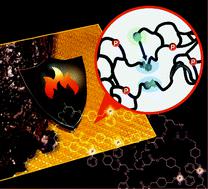当前位置:
X-MOL 学术
›
Polym. Chem.
›
论文详情
Our official English website, www.x-mol.net, welcomes your
feedback! (Note: you will need to create a separate account there.)
Intrinsic flame retardant phosphonate-based vitrimers as a recyclable alternative for commodity polymers in composite materials
Polymer Chemistry ( IF 4.1 ) Pub Date : 2020-06-08 , DOI: 10.1039/d0py00275e Jens C. Markwart 1, 2, 3 , Alexander Battig 3, 4, 5 , Tobias Urbaniak 3, 6, 7 , Katharina Haag 3, 6, 7 , Katharina Koschek 3, 6, 7 , Bernhard Schartel 3, 6, 7 , Frederik R. Wurm 1, 2, 3
Polymer Chemistry ( IF 4.1 ) Pub Date : 2020-06-08 , DOI: 10.1039/d0py00275e Jens C. Markwart 1, 2, 3 , Alexander Battig 3, 4, 5 , Tobias Urbaniak 3, 6, 7 , Katharina Haag 3, 6, 7 , Katharina Koschek 3, 6, 7 , Bernhard Schartel 3, 6, 7 , Frederik R. Wurm 1, 2, 3
Affiliation

|
Recycling of crosslinked fiber-reinforced polymers is difficult. Moreover, as they are often based on flammable resins, additional additives are needed. So-called “vitrimers” open the possibility of recycling and reprocessing and repairing with dynamically crosslinked chemistries. To date, vitrimer-based composites still need flame retardant additives, such as organophosphates. An additive-free vitrimer composite has not been reported. Herein, we synthesized an intrinsic flame-retardant vitrimer, relying on vinylogous polyurethanes containing covalently installed phosphonates as flame-retardant units and prepared glass-fiber-reinforced composites. We studied recycling and flame retardant properties and compared the data to phosphorus-free vitrimers and conventional epoxy resins (with and without additive flame retardant). Our phosphonate-based vitrimer proved in first tests, a flame retardant effect comparable to commercial flame retardant resins. The bending strength and bending modulus for the phosphorus-vitrimer glass fiber composites were comparable to glass fiber composites with permanently cross-linked epoxies. In summary, we were able to prove that the covalent installation of phosphonates into vitrimers allows the preparation of recyclable and intrinsic flame retardant composites that do not need flame retardant additives. We believe this concept can be expanded to other polymer networks and additives to generate recyclable and sustainable high-performance materials.
中文翻译:

固有的基于阻燃剂膦酸酯的微晶粉可作为复合材料中商品聚合物的可回收替代品
交联的纤维增强聚合物的再循环是困难的。此外,由于它们通常基于易燃树脂,因此需要其他添加剂。所谓的“ vitrimers”为利用动态交联化学物质进行回收,再加工和修复提供了可能性。迄今为止,基于三聚体的复合材料仍需要阻燃添加剂,例如有机磷酸盐。尚无无添加剂的三聚体复合物的报道。在此,我们依靠含有共价安装的膦酸酯的乙烯基聚氨酯作为阻燃剂单元,合成了一种固有的阻燃微晶玻璃,并制备了玻璃纤维增强复合材料。我们研究了回收利用和阻燃性能,并将数据与无磷的三聚体和常规环氧树脂(有或没有添加阻燃剂)进行了比较。我们的基于膦酸酯的三聚体在第一批测试中得到证明,其阻燃效果可与市售阻燃树脂媲美。磷玻璃纤维玻璃纤维复合材料的弯曲强度和弯曲模量可与具有永久交联环氧树脂的玻璃纤维复合材料相比。总而言之,我们能够证明将膦酸酯共价安装到微粉单体中可以制备不需要阻燃添加剂的可回收和固有阻燃复合材料。我们认为,这一概念可以扩展到其他聚合物网络和添加剂,以产生可回收和可持续的高性能材料。磷玻璃纤维玻璃纤维复合材料的弯曲强度和弯曲模量可与具有永久交联环氧树脂的玻璃纤维复合材料相比。总而言之,我们能够证明将膦酸酯共价安装到微粉单体中可以制备不需要阻燃添加剂的可回收和固有阻燃复合材料。我们相信,这一概念可以扩展到其他聚合物网络和添加剂,以产生可回收和可持续的高性能材料。磷玻璃纤维玻璃纤维复合材料的弯曲强度和弯曲模量可与具有永久交联环氧树脂的玻璃纤维复合材料相比。总而言之,我们能够证明将膦酸酯共价安装到微粉单体中可以制备不需要阻燃添加剂的可回收和固有阻燃复合材料。我们相信,这一概念可以扩展到其他聚合物网络和添加剂,以产生可回收和可持续的高性能材料。
更新日期:2020-08-06
中文翻译:

固有的基于阻燃剂膦酸酯的微晶粉可作为复合材料中商品聚合物的可回收替代品
交联的纤维增强聚合物的再循环是困难的。此外,由于它们通常基于易燃树脂,因此需要其他添加剂。所谓的“ vitrimers”为利用动态交联化学物质进行回收,再加工和修复提供了可能性。迄今为止,基于三聚体的复合材料仍需要阻燃添加剂,例如有机磷酸盐。尚无无添加剂的三聚体复合物的报道。在此,我们依靠含有共价安装的膦酸酯的乙烯基聚氨酯作为阻燃剂单元,合成了一种固有的阻燃微晶玻璃,并制备了玻璃纤维增强复合材料。我们研究了回收利用和阻燃性能,并将数据与无磷的三聚体和常规环氧树脂(有或没有添加阻燃剂)进行了比较。我们的基于膦酸酯的三聚体在第一批测试中得到证明,其阻燃效果可与市售阻燃树脂媲美。磷玻璃纤维玻璃纤维复合材料的弯曲强度和弯曲模量可与具有永久交联环氧树脂的玻璃纤维复合材料相比。总而言之,我们能够证明将膦酸酯共价安装到微粉单体中可以制备不需要阻燃添加剂的可回收和固有阻燃复合材料。我们认为,这一概念可以扩展到其他聚合物网络和添加剂,以产生可回收和可持续的高性能材料。磷玻璃纤维玻璃纤维复合材料的弯曲强度和弯曲模量可与具有永久交联环氧树脂的玻璃纤维复合材料相比。总而言之,我们能够证明将膦酸酯共价安装到微粉单体中可以制备不需要阻燃添加剂的可回收和固有阻燃复合材料。我们相信,这一概念可以扩展到其他聚合物网络和添加剂,以产生可回收和可持续的高性能材料。磷玻璃纤维玻璃纤维复合材料的弯曲强度和弯曲模量可与具有永久交联环氧树脂的玻璃纤维复合材料相比。总而言之,我们能够证明将膦酸酯共价安装到微粉单体中可以制备不需要阻燃添加剂的可回收和固有阻燃复合材料。我们相信,这一概念可以扩展到其他聚合物网络和添加剂,以产生可回收和可持续的高性能材料。









































 京公网安备 11010802027423号
京公网安备 11010802027423号